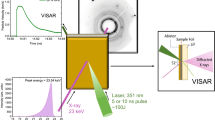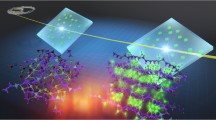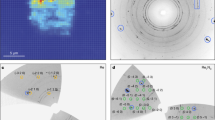Abstract
Alumina (α-Al2O3) has been widely used as a pressure calibrant in static high-pressure experiments1,2,3,4 and as a window material in dynamic shock-wave experiments5,6,7,8,9,10,11,12,13,14; it is also a model material in ceramic science. So understanding its high-pressure stability and physical properties is crucial for interpreting such experimental data, and for testing theoretical calculations15,16,17,18,19,20,21. Here we report an in situ X-ray diffraction study of alumina (doped with Cr3+) up to 136 GPa and 2,350 K. We observe a phase transformation that occurs above 96 GPa and at high temperatures. Rietveld full-profile refinements show that the high-pressure phase has the Rh2O3 (II) (Pbcn) structure, consistent with theoretical predictions22. This phase is structurally related to corundum, but the AlO6 polyhedra are highly distorted, with the interatomic bond lengths ranging from 1.690 to 1.847 Å at 113 GPa. Ruby luminescence spectra from Cr3+ impurities within the quenched samples under ambient conditions show significant red shifts and broadening, consistent with the different local environments of chromium atoms in the high-pressure structure inferred from diffraction. Our results suggest that the ruby pressure scale needs to be re-examined in the high-pressure phase, and that shock-wave experiments using sapphire windows need to be re-evaluated.
This is a preview of subscription content, access via your institution
Access options
Subscribe to this journal
Receive 12 print issues and online access
$259.00 per year
only $21.58 per issue
Buy this article
- Purchase on Springer Link
- Instant access to full article PDF
Prices may be subject to local taxes which are calculated during checkout




Similar content being viewed by others
References
Mao, H.K., Bell, P.M., Shaner, J.W. & Steinberg, D.J. Specific volume measurements of Cu, Mo, Pd, and Ag and calibration of the ruby R1 fluorescence pressure gauge from 0.06 to 1 Mbar. J. Appl. Phys. 49, 3276–3283 (1978).
Xu, J., Mao, H.K. & Bell, P.M. High pressure ruby and diamond fluorescence: Observations at 0.21 to 0.55 terapascal. Science 232, 1404–1406 (1986).
Jephcoat, A.P., Hemley, R.J. & Mao, H.K. X-ray diffraction of Cr3+: Al2O3 to 175 GPa. Physica B 150, 115–121 (1988).
Funamori, N. & Jeanloz, R. High-pressure transformation of Al2O3 . Science 278, 1109–1111 (1997).
Urtiew, P.A. & Grover, R. Temperature deposition caused by shock interactions with material interfaces. J. Appl. Phys. 45, 140–145 (1974).
Grover, R. & Urtiew, P.A. Thermal relaxation at interfaces following shock compression. J. Appl. Phys. 45, 146–152 (1974).
Urtiew, P.A. Effect of shock loading on transparency of sapphire crystals. J. Appl. Phys. 45, 3490–3493 (1974).
Bass, J., Svendsen, B. & Ahrens, T.J. in High Pressure Research in Mineral Physics (eds Manghnani, M. H. & Syono, Y.) 393–402 (Geophys. Monogr. Ser. 39, American Geophysical Union, Washington DC, 1987).
Nellis, W.J. & Yoo, C.S. Issues concerning shock temperature measurements of iron and other metals. J. Geophys. Res. 95, 21749–21752 (1990).
McQueen, R.G. & Isaak, D.G. Characterizing windows for shock wave radiation studies. J. Geophys. Res. 95, 21753–21765 (1990).
Yoo, C.S., Holmes, N.C. & See, E. in Shock Compression of Condensed Matter (eds Schmidt, S. C., Dick, R. D., Forbes, J. W. & Tasker, D. G.) 733–736 (Elsevier Science, Amsterdam, 1992).
Weir, S.T., Mitchell, A.C. & Nellis, W.J. Electrical resistivity of single-crystal Al2O3 shock-compressed in the pressure range 91–220 GPa (0.91–2.2 Mbar). J. Appl. Phys. 80, 1522–1525 (1996).
Mashimo, T. et al. High-pressure phase transformation of corundum (α-Al2O3) observed under shock compression. Geophys. Res. Lett. 27, 2021–2024 (2000).
Hama, J. & Suito, K. The evidence for the occurrence of two successive transitions in Al2O3 from the analysis of Hugoniot data. High Temp. High Press. 34, 323–334 (2002).
Cohen, R. Calculation of elasticity and high pressure instabilities in corundum and stishovite with the potential induced breathing model. Geophys. Res. Lett. 14, 37–40 (1987).
Cynn, H., Isaak, D.G., Cohen, R.E., Nicol, M.F. & Anderson, O.L. A high-pressure phase transition of corundum predicted by the potential induced breathing model. Am. Mineral. 75, 439–442 (1990).
Marton, F.C. & Cohen, R.E. Prediction of a high-pressure phase in Al2O3 . Am. Mineral. 79, 789–792 (1994).
Thomson, K.T., Wentzcovitch, R.M. & Bukowinski, M.S.T. Polymorphs of alumina predicted by first principles: Putting pressure on the ruby pressure scale. Science 274, 1880–1882 (1996).
Duan, W., Wentzcovitch, R.M. & Thomson, K.T. First-principles study of high-pressure alumina polymorphs. Phys. Rev. B 57, 10363–10369 (1998).
Duan, W., Paiva, G., Wentzcovitch, R.M. & Fazzio, A. Optical transitions in ruby across the corundum to Rh2O3 (II) phase transformation. Phys. Rev. Lett. 81, 3267–3270 (1998).
Duan, W., Karki, B.B. & Wentzcovitch, R.M. High-pressure elasticity of alumina studied by first principles. Am. Mineral. 84, 1961–1966 (1999).
Shannon, R.D. & Prewitt, C.T. Synthesis and structure of a new high-pressure form of Rh2O3 . J. Solid State Chem. 2, 134–136 (1970).
Holmes, N.C., Moriarty, J.A., Gathers, G.R. & Nellis, W.J. The equation of state of platinum to 660 GPa (6.6 Mbar). J. Appl. Phys. 66, 2962–2967 (1989).
Lin, J.F., Shu, J., Mao, H.K., Hemley, R.J. & Shen, G. Amorphous boron gasket in diamond anvil cell research. Rev. Sci. Instrum. 74, 4732–4736 (2003).
Shen, G., Rivers, M.L., Wang, Y. & Sutton, S.R. Laser heated diamond cell system at the Advanced Photon Source for in situ X-ray measurements at high pressure and temperature. Rev. Sci. Instrum. 72, 1273–1282 (2001).
Watanuki, T., Shimomura, O., Yagi, T., Kondo, T. & Isshiki, M. Construction of laser-heated diamond anvil cell system for in situ x-ray diffraction study at SPring-8. Rev. Sci. Instrum. 72, 1289–1292 (2001).
Hammersley, A.P. FIT2D V10.3 Reference Manual V4.0 (European Synchrotron Radiation Facility, Grenoble, 1998).
Larson, A.C. & Von Dreele, R.B. GSAS Manual (Report LAUR 86–748, Los Alamos National Laboratory, Los Alamos, 1988).
Rozenberg, G. Kh. et al. High-pressure structural studies of hematite Fe2O3 . Phys. Rev. B 65, 064112 (2002).
Sobolev, N.V. et al. Fossilized high pressure from the Earth's deep interior: The coesite-in-diamond barometer. Proc. Natl Acad. Sci. 97, 11875–11879 (2000).
Acknowledgements
We thank the staff at the BL10XU sector of SPring-8, Japan, and at the HPCAT and GSECARS sectors of the Advanced Photon Source, Argonne National Laboratory, for help with the synchrotron facilities. We also thank G. Shen, V. Prakapenka, M. Yue, O. Yasuo and J. Shu for their assistance in the experiments, and C. Sanloup, R. Hazen, M. Somayazulu, R. Cohen, S. Merkel, Y. Fei and S. Hardy for discussions. This work was supported by the NSF (grant EAR-0217389). Work at Carnegie was supported by DOE/BES, DOE/NNSA (CDAC no. DE-FC03-03NA00144), the NSF and the W.M. Keck Foundation.
Author information
Authors and Affiliations
Corresponding author
Ethics declarations
Competing interests
The authors declare no competing financial interests.
Supplementary information
Supplementary Information, Fig. S1
Supplementary Information, Fig. S2 (PDF 150 kb)
Rights and permissions
About this article
Cite this article
Lin, JF., Degtyareva, O., Prewitt, C. et al. Crystal structure of a high-pressure/high-temperature phase of alumina by in situ X-ray diffraction. Nature Mater 3, 389–393 (2004). https://doi.org/10.1038/nmat1121
Received:
Accepted:
Published:
Issue Date:
DOI: https://doi.org/10.1038/nmat1121
This article is cited by
-
Thermodynamic Properties and Equation of State for Alpha-Alumina
International Journal of Thermophysics (2024)
-
Solution-combustion Synthesized Nano-pellet α-Al2O3 and Catalytic Oxidation of Cyclohexane by Its Supported Cobalt Acetate
Journal of Wuhan University of Technology-Mater. Sci. Ed. (2021)
-
Permafrost Analysis Methodology (PAM) for Ceramic Shell Deformation in the Firing Process
International Journal of Metalcasting (2019)
-
Crystalline polymeric carbon dioxide stable at megabar pressures
Nature Communications (2018)
-
Spectroscopic study of inclusions in gem corundum from Mercaderes, Cauca, Colombia
Physics and Chemistry of Minerals (2017)



